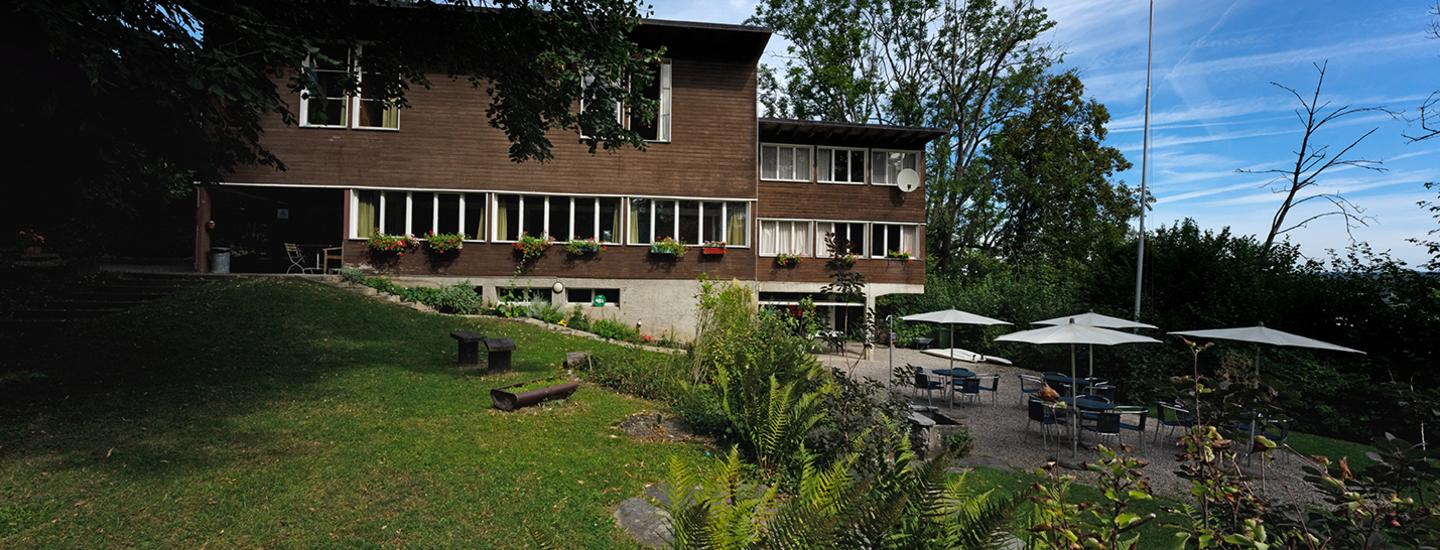
Fällanden
Filter Hostels
What about a camp, family outing or party at beautiful Greifen Lake? The venerable Emil Roth-designed hostel welcomes groups of ten people or more.
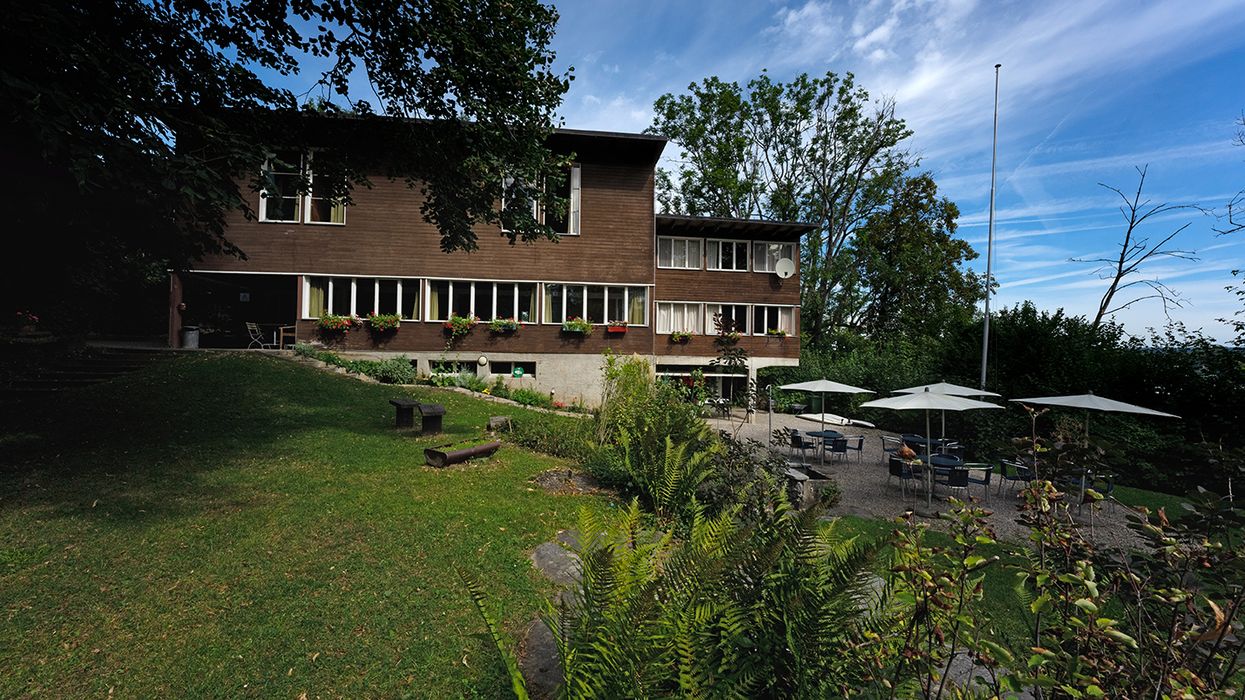
Fällanden
Zurich
Cyclists and mountain bikers, inline skaters, hikers, water sports fans, nature lovers and steamboat enthusiasts all meet at Greifen Lake. The fens and reed belts along the lake are protected and provide a peaceful home to over 400 plant species and 120 migratory bird species. In June and July, the sun sets where the lake meets the horizon, treating us to especially stunning sunsets. The group house has access to the lake – a real privilege because the majority of the lake shore area is protected. The offer includes a raft, a boat and a large playing field with a volleyball net, table tennis table and barbecue area. The accommodation is always reserved for the exclusive use of just one group.
![[Translate to Englisch:]](/fileadmin/_processed_/4/c/csm_Faellanden-jugendherbergen-map%403x_2_ad47aab94d.png)
-
Fällanden Youth Hostel
Im Rohrbuck
Maurstrasse 33
8117 Fällanden
Switzerland -
Check-in: 00:00 - 00:00 Check-out: 00:00 - 00:00
-
Details on opening hours
Types 2024 2025 Opening dates Opening dates 08.03.2024 - 03.11.2024 07.03.2025 - 02.11.2025 Check In/Out Check-in 00:00 - 00:00 00:00 - 00:00 Check-out 00:00 - 00:00 00:00 - 00:00 Reception times Mon to Fri: 00:00 - 00:00 00:00 - 00:00 Sat and Sun: 00:00 - 00:00 00:00 - 00:00 Meal times Breakfast buffet 00:00 - 00:00 00:00 - 00:00
Opening times
| Types | 2024 | 2025 |
|---|---|---|
| Opening dates | ||
| Opening dates | 08.03.2024 - 03.11.2024 | 07.03.2025 - 02.11.2025 |
| Check In/Out | ||
| Check-in | 00:00 - 00:00 | 00:00 - 00:00 |
| Check-out | 00:00 - 00:00 | 00:00 - 00:00 |
| Reception times | ||
| Mon to Fri: | 00:00 - 00:00 | 00:00 - 00:00 |
| Sat and Sun: | 00:00 - 00:00 | 00:00 - 00:00 |
| Meal times | ||
| Breakfast buffet | 00:00 - 00:00 | 00:00 - 00:00 |
How to find us
By train:
From Zürich main station to Stettbach station by train. Change to bus 743 and get of at the '"Jugendherberge" stop.
By car:
Parking spaces available for cars and coaches next to the youth hostel.
Room categories
-
Number of beds
-
Double rooms
-
Shared rooms
Infrastructure
Prices (in CHF) and availability
-
Further price information
Overnight stay
Bed linen included, without food and drink (self-catering kitchen available)
Peak season: May, June, July, Aug, Sept
Low season: March / April and October until beginning of NovemberCHF Weekend package Fri-Sun (up to 25 people) low season 1160.– Weekdays Mon-Fri per night (up to 25 persons) low season 400.– Surcharge per person from 26th person low season 18.– Weekend package Fri-Sun (up to 25 people) high season 1360.– Weekdays Mon-Fri per night (up to 25 persons) high season 490.– Surcharge per person from 26th person peak season 20.– Building must be returned swept clean, otherwise final cleaning service 150.– Obligatory Hostel Card Premium (for groups personal/impersonal) 55.–/99.– - On weekdays, a minimum stay of Monday to Friday applies.
- Check-in and check-out times can be arranged individually.
- No taxes
- You have the option to purchase a Membercard, which enables you to benefit from lower accommodation rates. Become a member now!
- Accommodation of dogs on request CHF 15.- per dog and night, without food
- Voluntary climate protection contribution CHF 0.30
- Rates are subject to change
- All rates in CHF
-
History
Swiss architectural history alongside Lake Greifensee
The youth associations in the city of Zurich had long nurtured the dream of having a hostel in the country. Organised in the Zurich Youth Hostels Association, the idea gradually evolved into tangible form and the search for a suitable piece of land began.
The preferred location on Lake Zurich would have exceeded the financial resources of the time by a wide margin however, with the result that nearby Lake Greifensee was chosen instead.
Emil Roth
Zurich architect Emil Roth was entrusted with the planning. Born in Bari in 1893 as the son of an expatriate Swiss, his family returned to Switzerland where he completed part of his schooling alongside Lake Constance and studied architecture at the ETH Zurich from 1911. A serious lung disease contracted after beginning his active military service forced him to break off his education. Once Emil Roth was healed and able to leave the sanatorium world, he worked as an assistant in a wide number of building trades and it was not until 1922 that he recommenced working as a trainee planner in a Basel architectural practice.
He was co-founder of the important avant-garde magazine “ABC” and its first editorial employee. As a result, he soon also gained an international reputation. This is also the time of the collaboration in El Lissitzky’s project of the “Wolkenbügel”, one of the most important contributions of the Russian constructivist architecture. In addition, he planned – in cooperation with the architects Hubacher & Steiger, Artaria & Schmidt and Häfeli – the Werkbund housing estate “Neubühl“ in Zurich, which is probably the most important housing estate of the classical modernism in Switzerland in the form that manifested itself in Germany with Bauhaus during the interwar period.
The building
The programmatic objectives of modernism, such as simplicity and functionality were tailor-made for the task of designing a youth hostel. Roth manifested them through uncompromising rejection of all decorative elements. Here, the materialisation in wood and the traditional post-and-beam construction created an interesting thematic link to Switzerland and its craft professions.
Realisation of the project started out on a somewhat uncertain footing. It was only possible to meet the construction budget at the time of CHF 70,000.- thanks to support from the City of Zurich, the Canton, private donations and many hours of voluntary work on the part of young people and tradesmen.
On 6 June 1937, Fällanden Youth Hostel was officially opened. Just two years later in 1939, Emil Roth by now seriously ill again, retired from architecture. This means that the youth hostel, alongside the Werkbund’s housing estate Neubühl and the Doldertal houses realised in collaboration with his cousin Alfred Roth, is regarded as one of his main works and also the only one realised completely on his own. The youth hostel is today protected as a historic monument by the cantonal and federal authorities.
The youth hostel was designed to accommodate 70 persons. This meant that it soon found itself among the smaller youth hostels and was often heavily overbooked due to its outstanding location. Nevertheless, comfort was a long time coming. Hot water was only installed in the showers in the course of restoration work in the 1970’s. In 1981 a part of the building was burnt out and within 4 months it was rebuilt to a better standard.

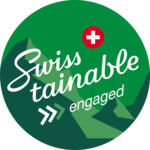
![[Translate to Englisch:] Solar Label Logo Solarkit](/fileadmin/_processed_/5/9/csm_Solarkit_Logo_c5dfe2dd35.png)
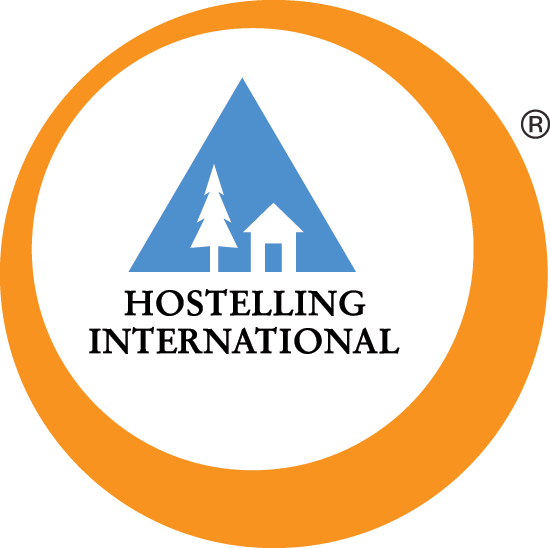
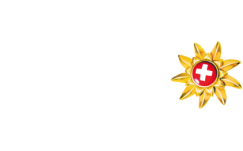
Share this page